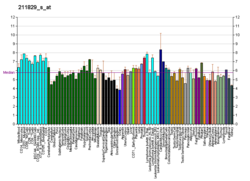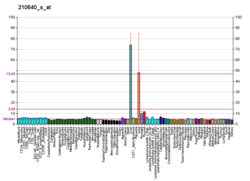Role in cancer
GPER expression has been studied in cancer using immunohistochemical and transcriptomic approaches, and has been detected in: colon, lung, melanoma, pancreatic, breast, [23] ovarian, [24] and testicular cancer. [25]
Many groups have demonstrated that GPER signaling is tumor suppressive in cancers that are not traditionally hormone responsive, including melanoma, pancreatic, lung and colon cancer. [26] [27] [28] [29] Additionally, many groups have demonstrated that GPER activation is also tumor suppressive in cancers that are classically considered sex hormone responsive, including endometrial cancer, ovarian cancer, prostate cancer, and Leydig cell tumors. [30] [31] [32] [33] [34] Although GPER signaling was originally thought to be tumor promoting in some breast cancer models, [35] subsequent reports show that GPER signaling inhibits breast cancer. [36] [37] [38] Consistent with this, recent studies showed that the presence of GPER protein in human breast cancer tissue correlates with longer survival. [39] In summary, many independent groups have demonstrated that GPER activation may be a therapeutically useful mechanism for a wide range of cancer types.
Linnaeus Therapeutics is currently running NCI clinical trial (NCT04130516) using GPER agonist, LNS8801, as monotherapy and in combination with the immune checkpoint inhibitor, pembrolizumab, for the treatment of multiple solid tumor malignancies. Activation of GPER with LNS8801 has demonstrated efficacy in humans in cutaneous melanoma, uveal melanoma, lung cancer, neuroendocrine cancer, colorectal cancer, and other PD-1 inhibitor refractory cancers. [40] [41] [42]
Role in normal tissues
Cardiovascular effects
GPER is expressed in the blood vessel endothelium and is responsible for vasodilation and as a result, blood pressure lowering effects of estradiol. [49] GPER also regulates components of the renin–angiotensin system, which also controls blood pressure, [50] [51] and is required for superoxide-mediated cardiovascular function and aging. [52]
Central nervous system activity
GPER and ERα, but not ERβ, have been found to mediate the antidepressant-like effects of estradiol. [53] [54] [55] Contrarily, activation of GPER has been found to be anxiogenic in mice, while activation of ERβ has been found to be anxiolytic. [56] There is a high expression of GPER, as well as ERβ, in oxytocin neurons in various parts of the hypothalamus, including the paraventricular nucleus and the supraoptic nucleus. [55] [57] It is speculated that activation of GPER may be the mechanism by which estradiol mediates rapid effects on the oxytocin system, [55] [57] for instance, rapidly increasing oxytocin receptor expression. [58] Estradiol has also been found to increase oxytocin levels and release in the medial preoptic area and medial basal hypothalamus, actions that may be mediated by activation of GPER and/or ERβ. [58] Estradiol, as well as tamoxifen and fulvestrant, have been found to rapidly induce lordosis through activation of GPER in the arcuate nucleus of the hypothalamus of female rats. [59] [60]
Female GPER knockout mice display hyperglycemia and impaired glucose tolerance, reduced body growth, and increased blood pressure. [61] Male GPER knockout mice are observed to have increased growth, body fat, insulin resistance and glucose intolerance, dyslipidemia, increased osteoblast function (mineralization), resulting in higher bone mineral density and trabecular bone volume, and persistent growth plate activity resulting in longer bones. [62] [63] The GPER-selective agonist G-1 shows therapeutic efficacy in mouse models of obesity and diabetes. [64]
Role in neurological disorders
GPER is broadly expressed on the nervous system, and GPER activation promotes beneficial effects in several brain disorders. [65] A study suggests that GPER levels were significantly lower in children with ADHD compared to controls. [66]
This page is based on this
Wikipedia article Text is available under the
CC BY-SA 4.0 license; additional terms may apply.
Images, videos and audio are available under their respective licenses.





